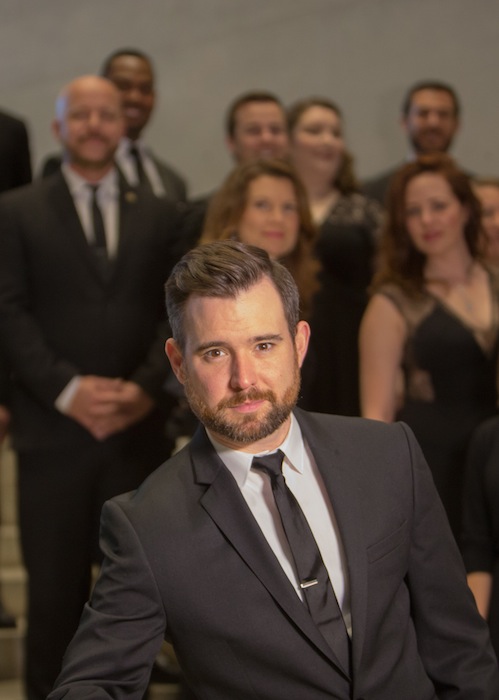Seraphic Fire closes series memorably with Pärt’s meditative “Passio”

Patrick Quigley conducted Seraphic Fire in Arvo Pärt’s “Passio” Friday night at United Methodist Church in Coral Gables.
Seraphic Fire’s “Parables of Passion” series has produced some of the season’s most memorable performances. Presentations of David Lang’s luminous little match girl passion and the original version of Bach’s St. Matthew Passion were musically scrupulous, outstanding listening experiences.
Artistic director Patrick Quigley saved the most unique program in this series for last. On Friday night Quigley led Arvo Pärt’s Passio Domini Nostri Jesu Christi secundum Joannem at First United Methodist Church in Coral Gables. The performance was yet another landmark in the choir’s remarkable sixteen-year history.
Pärt’s 1982 setting of the Passion According to St. John is less a sacred choral dramatization of the trial and crucifixion of Jesus Christ in the manner of Bach than a meditation on the Biblical story. In pre performance remarks, Quigley called the work a “sonic installation,” steeped in Pärt’s intensive study of 14th- and 15th-century music. Gregorian chant and Medieval modes play an important role in the score but the Estonian composer’s unique brand of spiritual minimalism dominates this 65- minute work. The composer defined his self identified “tintinnabuli” (bell) style as creating music where the melody and accompaniment are one. That contributes to the Passio’s trance-like stasis.
Instead of a single Evangelist, Pärt gives the narrative role to a vocal quartet, in which the soprano, alto, tenor and baritone each have solo and duo lines in addition to unison singing. Jesus is sung by a baritone and Pilatus (Pontius Pilate) by a tenor. The choir plays all of the other roles.
An ensemble of organ, violin, cello, oboe and bassoon comprises the instrumental component. Despite the drama of its Biblical genesis, the score is remarkably quiet and peaceful. Once the listener becomes attuned to Pärt’s repetitive calmness and mastery of vocal and instrumental layering of textures, the work is both moving and deeply satisfying in its aura of serenity.
Conducting seated, Quigley led a superb performance that gave equal weight to the beauty of the score’s vocal writing and the spacious momentum that defines Pärt’s inexorable musical invention. Throughout the performance, tension never flagged. Quigley fielded a 17-voice choir, including nine singers from Seraphic Fire’s UCLA ensemble artist program.
In the opening pages and the closing “Amen” Quigley drew a stirring sound from the full chorus. For much of the work’s duration, choral textures were mellow and finely gauged, even in sections where the crowd called for Jesus’s death. Quigley smoothly coordinated the vocal and instrumental balances, keeping the volume and musical flow steady throughout Pärt’s musical discourse.
The Evangelist quartet is responsible for much of the score’s impact. Seated on the conductor’s right at the rear of the platform, the Seraphic foursome, individually and collectively, could hardly have been bettered.
Steven Eddy brought fine legato line to his solo declamation, his manly baritone consistently striking. Tenor Patrick Muehliese could refine his lyric sound down to the thinnest thread of tone and he blended mellifluously with Eddy’s darker sonority.
The women’s voices expressed Pärt’s ethereal, other worldly sound palette. Jolle Greenleaf’s pure, vibratoless soprano rose in tones both resplendent and soothing. Virginia Warnken’s mezzo abounded with strength and finely placed vocal coloration. Toward the work’s conclusion, the quartet’s vocal lines become more expansive and the singers’ well-balanced timbres produced some of the evening’s most beautiful moments.
James K. Bass’ rotund bass and steady, even declamation commanded attention at Jesus’s every utterance. The softness of his final dying line “It is consummated” was riveting. Steven Soph’s forceful tenor with a slight edge at the top was perfect for Pilatus’s dissonant paragraphs. In repetitive consecutive solos, there was a striking contrast in the projection and vocal nuances of Soph and Muehleise’s tenor voices.
The organ acts as a Bachian “halo” around Jesus’s words in a quiet, discreet manner but becomes more prominent in accompanying Pilatus. Yu “Dean” Zhang masterfully gauged the instrument’s sonority, providing just the right support for the individual vocal parts and the choir.
The sweetness and warmth of Max Blair’s oboe stood out, particularly when accompanying Greenleaf’s solos. Eddie Burns’s bassoon brought firmness to the ensemble writing and violinist Sonya Chung and cellist Grace An coalesced wonderfully with the vocal textures.
There are two remaining performances of this singular choral masterpiece which displays Seraphic Fire at its considerable best.
Seraphic Fire repeats Arvo Pärt’s Passio 7:30 p.m. Saturday at All Saints Episcopal Church in Fort Lauderdale and 4 p.m. Sunday at Vanderbilt Presbyterian Church in Naples. seraphicfire.org
Posted in Performances
Leave a Comment
Sat Apr 14, 2018
at 2:08 pm
No Comments




